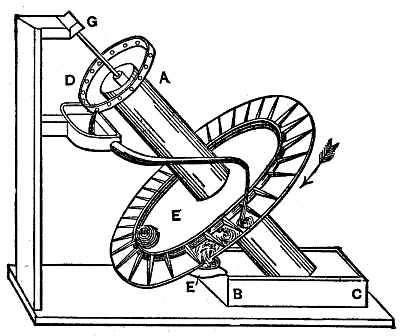Mercurial
wheel
A is the screw
turning on its two pivots; B is a cistern to be filled above the level
of the lower aperture of the screw with mercury; D is a reservoir,
which, when the screw is turned round, receives the mercury which falls
from the top.

A pipe conveys
the mercury from the reservoir on to the float-board,
E, fixed at right angles to the center of the screw, and furnished at
its circumference with ridges to intercept the mercury, the momentum
and weight of which will cause the float-board and screw to revolve,
until, by the proper inclination of the floats, the mercury falls into
the receiver, E, from whence it again falls by its spout into the
cistern, B, where the constant revolution of the screw takes it up
again as before.
(Subsection 938, from
p.375)
From: Gardner D. Hiscox, M.E., Mechanical Appliances and Novelties of Construction (1927), Norman W. Henley Publ. Co.






